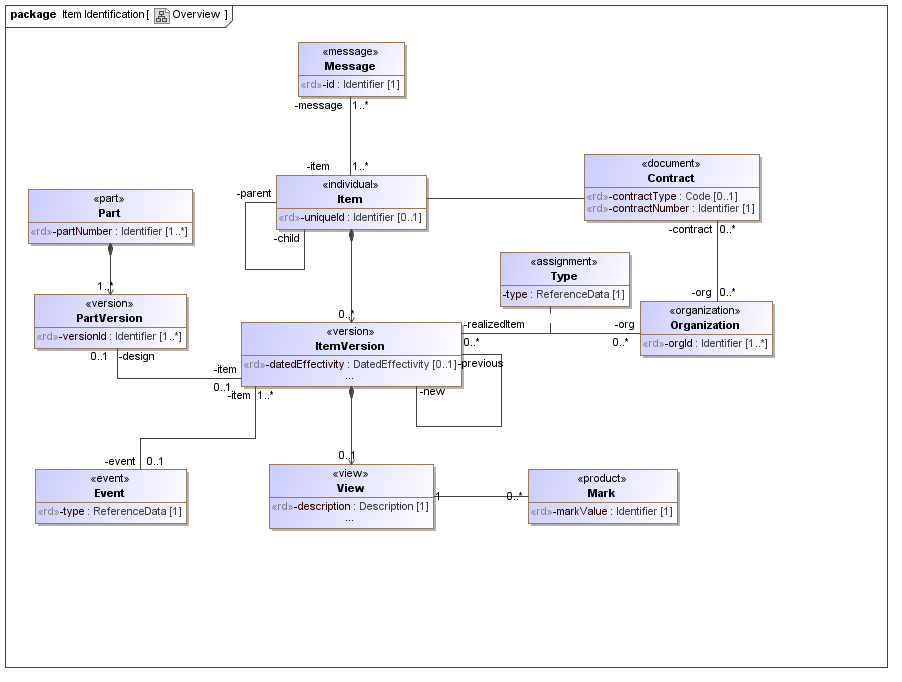
| DEX: (D012) item_identification — Item Identification | Date: 2011/07/04 01:21:03 Revision: 1.81 |
The Information Overview section provided a high level overview of the business information that can be represented by this DEX. This section provides a more detailed overview of that information. A description of how to represent this information using ISO 10303-239 PLCS is provided in the Item Identification: ISO 10303-239 Representation section.
A detailed view of the information to be exchanged is provided by the UML model in Figure 11. The figure depicts the overall UML Class Model for item identification, containing detailed requirements as specified below. This overview is the overall UML Class Model for item identification information, into which each detailed requirement below is fitted.

NOTE The information shown in the UML class diagram in Figure 11 is intended to illustrate the type of information that can be represented by the DEX. For data exchange, only the mandatory set of data shall be populated. The purpose of each instance of data exchange will dictate the need for population of the optional data.
Information related to the Item Identification ISO 10303-239 representation - Table of contents:
When information is exchanged between two IT systems, messages are transmitted from the sending or source system (sender) to the receiving system (receiver). A message provides a package of data to be exchanged.
A message includes the following information:
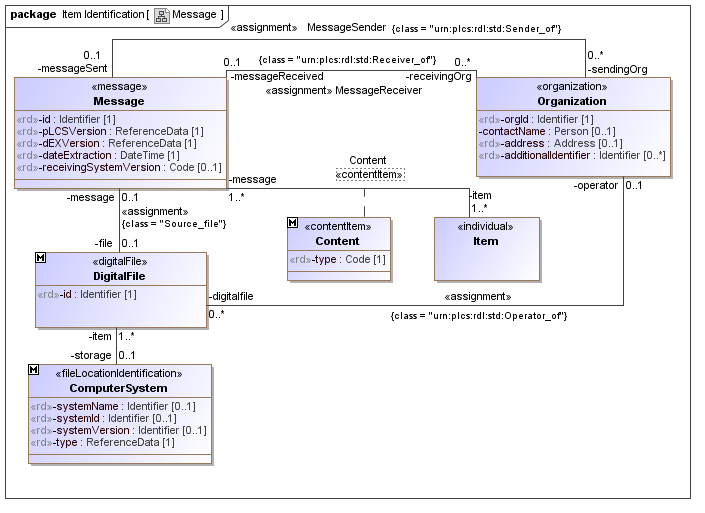
NOTE Details on the PLCS representation of the Message are defined in 239 Representation Message
Unique identification of the message specific to each organization.
Uniquely identified individual item.
Categorizes the message content as one of the following:
Version of PLCS used by the message.
Version of DEX used by the message.
Date the message was extracted from the sending system.
Version of the System that receives the message.
Identification of the message file in the source system.
The entity or organization that administrates or operates the application or system that generated the message.
Name of the application or system that generated the XML file.
Identification of the application or system that generated the XML file.
Version of the application or system that generated the XML file.
Classification of the application or system that generated the XML file.
The organization sending the message. An organization may have an address.
The organization receiving the message.
The Item in Focus is something tangible. The Item in Focus may either be an end item or an item embedded within a parent item.
An Item in Focus may be either a part, or an element in a logical breakdown structure of a defined end item.
NOTE A part or breakdown element may be the end item itself.
EXAMPLE The end item for an aircraft engine can be the aircraft if the engine is fitted within the aircraft. The engine can also be regarded as an end item e.g. when it is in a workshop.
Product as Individual may include the following information:
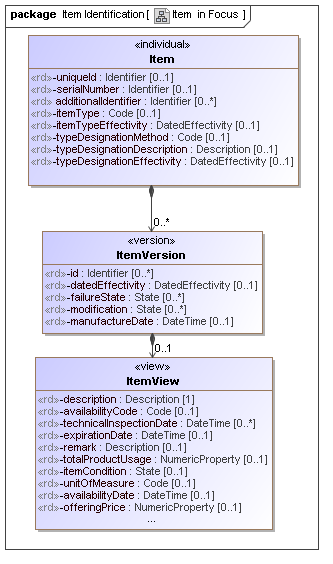
NOTE Details on the PLCS representation of the Item in Focus are defined in 239 Representation Item in Focus
Uniquely identified individual item.
Unique Identifier that ensures uniqueness of all items.
EXAMPLE Types of UID formats include UID1, VIN, etc.
Serial Number of the Item in Focus.
Additional identifier assigned to the item in addition to a Unique ID or Serial Number.
Date that the Item in Focus was manufactured.
NOTE An item can only have one manufacture date.
Date of a technical inspection(s) of the Item in Focus.
The date that the Item in Focus is expected to expire.
The identification and description of an item failure mode that has occurred.
Date of an item failure.
Item Type (Special Tooling or Special Test Equipment)
Indication of whether the Item in focus is considered to be special tooling or special test equipment or neither.
Date the item in focus was categorized as special tooling equipment, test equipment or neither.
Description of an item modification.
Date the item was modified.
Description of the Item in Focus.
Additional remark(s) regarding the Item in Focus that provides the user with helpful information.
Availability Code is an optional code that represents the product status within a system. It can either be available or unavailable and should be explicitly stated and defined within the Exchange Agreement.
Availability Date is the period of time that a product within a system exists as a particular availability status.
An indicator of the total usage of the Item in Focus at the time of reporting e.g. the vehicle has been driven 10000 Kilometers.
State that indicates the condition that the Item in Focus is in.
EXAMPLE Serviceable, Beyond Economic Repair, etc.
Indicator for the Type designation method in IUID.
Description of the Type Designation of the item in focus.
The date that type designation method of the item was made effective.
The date that an item in focus is available until.
The purchase price for an item in focus.
Item Design references the Item's design through a relationship with the Part that the Item is configured according to. Item Design defines the relationship between the Parent item and the embedded items that comprise it. As the Item evolves, the change history is recorded through a change in either its part version or batch/lot number.
NOTE The DEX holds information about the "as-is" configuration of the item, not the complete item design. It can also exchange historic "as-is" configurations.
Item Design may include the following information:
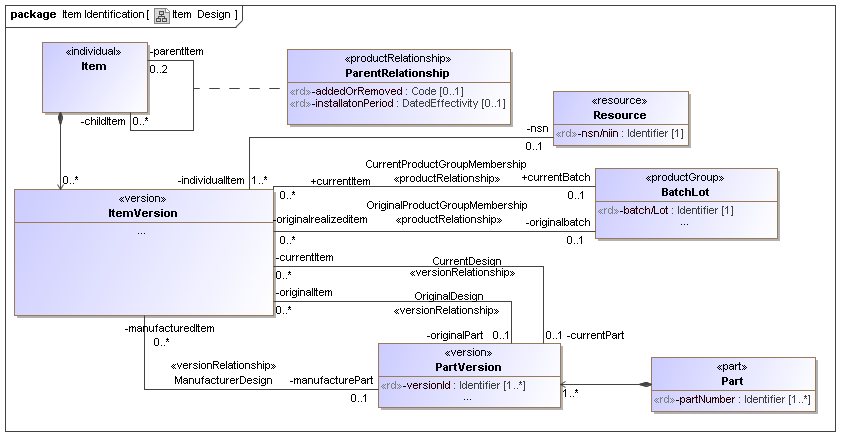
NOTE Details on the PLCS representation of the Item Design are defined in 239 Representation Item Design
Uniquely identified individual item.
Identification of the part an item is designed according to.
Part version that the Item in Focus was originally designed as e.g. "as-designed" configuration.
Part version that the Item in Focus was manufactured as e.g. "as-built" configuration.
Part version that the Item in Focus is currently designed as e.g. "as-is" configuration.
Identification of the batch or lot that the Item in Focus was or is currently grouped within.
Identification of the batch or lot that the Item in Focus was originally produced within.
Identification of the batch or lot that the Item in Focus is currently grouped within.
Identification of the part version of an item.
An item that is nested within another item or within the end product.
The parent of the Item in Focus e.g. the Item in Focus is embedded within the Parent Item.
NOTE The Parent Item can also be the Item in Focus. The Item with no parent is considered an end item.
For an embedded item, the period of time it was embedded within another item.
Code indicating whether an embedded item is added or removed from another item.
A code that identifies the item as a standardized material item of supply e.g. the NATO Stock number.
Item Marks are a mechanism for identifying the item through provision of either physical marks on the item or virtual marks. Mark provides a description of a physical marking on the item.
EXAMPLE A Unique Item Identifier (UII) is marked on an item through means of a 2D matrix.
Item Marks may comprise of the following data:
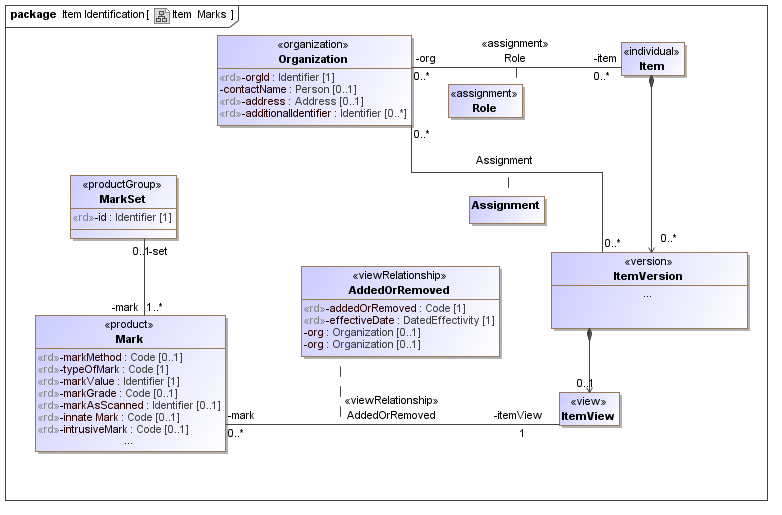
NOTE Details on the PLCS representation of the Item Marks are defined in 239 Representation Item Marks
Uniquely identified individual item.
Indicates the information physically contained within the mark as well as the type of information.
Period of time a mark is attached on the item.
Code indicating whether the mark was added or removed.
The organization responsible for marking the item.
Scanned value of a 2D mark.
Defines the mechanism by which the mark is affixed onto the Product as Realized as either placed on a bag that encapsulates the item, a tag placed on the item or neither.
Identifies the mechanism by which the mark is affixed onto the Product as Realized as either Intrusive or Non-intrusive.
Indicates whether the mark is an innate mark or not.
Describes the condition or quality of the mark.
Mechanism for grouping marks into sets.
The Item relates to organizations in different roles. E.g. the item may be transferred to an organization as part of a contractual agreement. The Item may be owned by an organization. The item was manufactured by an organization.
Item Organization may include the following information:
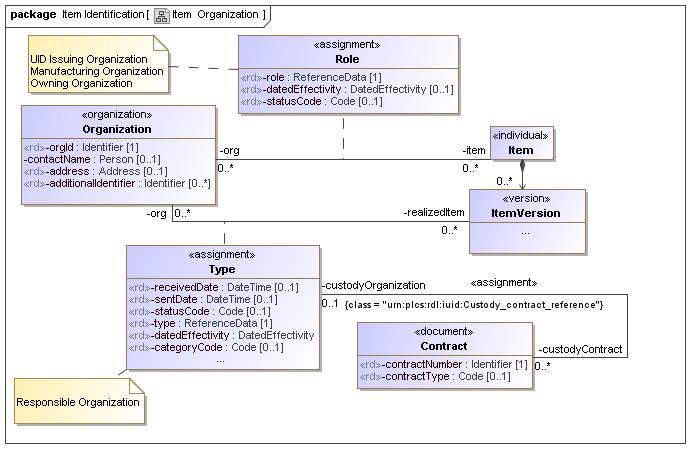
NOTE Details on the PLCS representation of the Item Organization are defined in 239 Representation Organization
Uniquely identified individual item.
Responsible Person or Organization
The person or organization that is responsible for the item e.g. the Item is in the custody of the responsible organization.
Code indicating the intended use of an item by the responsible organization e.g. a piece of equipment or a material.
An item can be treated as a piece of equipment or a material based on the following criteria:
Award instrument under which the item was subject to custody transfer.
The type of award instrument.
EXAMPLE Grant, International Agreement, DOD Contract, etc.
Date the item is sent to the responsible organization.
Date the item is received by the responsible organization.
Code classifying the previous and current responsible organization.
Period of time the responsible organization is responsible for the item.
Identification of the organization owning the Item in Focus.
Period of item ownership.
The organization that produces the Item in Focus.
NOTE The manufacturing organization may different from the Unique ID Issuing Organization.
The organization that assigns a Unique ID to the item.
The Item in Focus may be acquired by an organization through a procurement contract, with associated information.
Acquisition may include the following information:
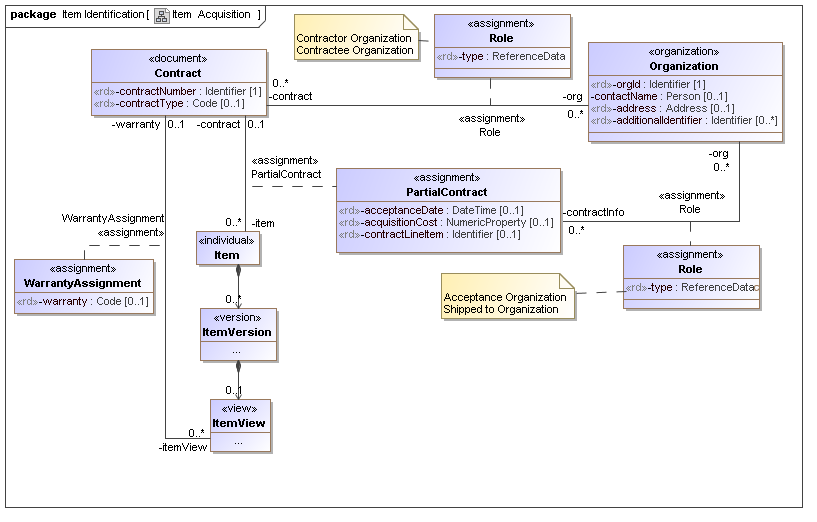
NOTE Details on the PLCS representation of the Item Acquisition are defined in 239 Representation Acquisition
Date the item is accepted by the Accepting Organization.
Purchase contract line item.
Unit Price as defined in the contract or as defined at delivery by the contractor. It is a numerical value.
International Organization of Standardization code from ISO 4217 representing the currency unit of Acquisition Cost.
Unique identifier for the award instrument under which the item(s) was acquired.
EXAMPLE A unique identifier for a contract, purchase order, BOA, Basic Agreement, or BPA.
The organization or department that accepts the item(s).
The organization that physically receives delivery of the item(s). It is not required to be the same organization as the accepting organization.
The organization that is responsible for delivering the item according to the contract specifications.
The organization that awards the contract for the acquisition of the item(s).
The type of award instrument.
EXAMPLE Grant, International Agreement, DOD Contract, etc.
Uniquely identified individual item.
An indicator of whether or not a warranty exists for the item.
Item Change encompasses various scenarios including, Item Failure, Item Modification and Item Rollover.
Item Failure is the result of a malfunction and does not result in a change to the form, fit or function of an end item or an embedded item. Item Modification refers to a change of an item that does not alter its form, fit or function. An Item Rollover refers to a change in the form, fit or function of an item.
Item Change may include the following data:
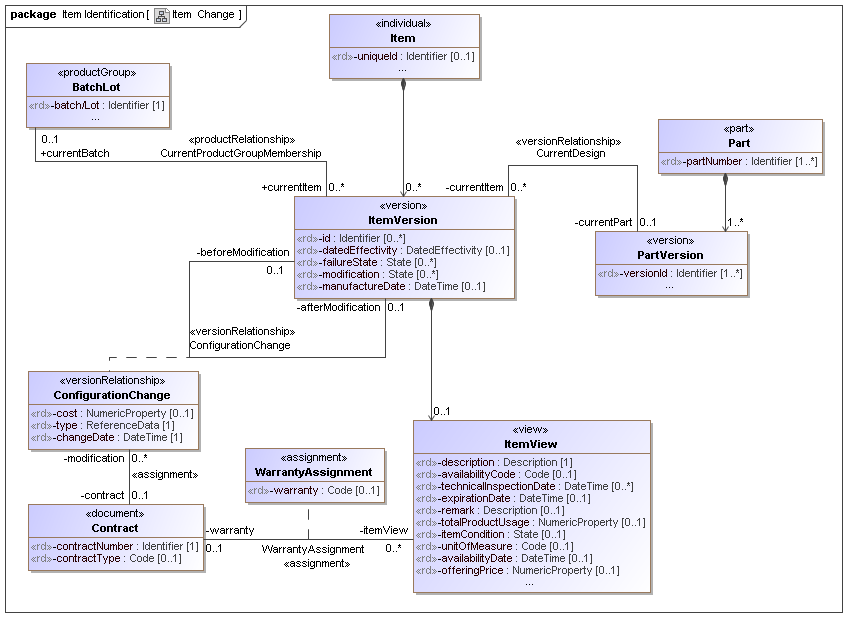
NOTE Details on the PLCS representation of the Item Change are defined in 239 Representation Item Change
Uniquely identified individual item.
Identification of the part an item was or is designed according to.
Identification of the part version of an item.
Part version that the Item in Focus is currently designed as.
Identification of the batch or lot that the Item in Focus was or is currently grouped within.
Identification of the batch or lot that the Item in Focus is currently grouped within.
Period of time that an item existed as a specific design or batchlot.
Type of configuration change applicability, i.e. batch/lot number or part number change.
New description of the item that reflects the configuration change.
Cost of the configuration change incurred by the owner of the item. It is a numerical value.
International Organization of Standardization code from ISO 4217 representing the currency unit of the cost.
Identification of the contract under which the Items form, fit and function change occurred.
Type of contract under which the Items form, fit and function change was authorized.
Indicates whether a new warranty is provided with the item due to the rollover or not.
Item Lifecycle Event defines a change in the state, condition or situation of an item. The nature of an event may be either terminating or non-terminating.
Terminating events are those that end the lifecycle of an item.
EXAMPLE Abandoned, consumed, destroyed, expended, lost, stolen, scrapped, etc.
Non-terminating events are those that don’t end the lifecycle of an item
EXAMPLE Donated, exchanged, leased, loaned, sold, reintroduction, retired, etc.
Item Lifecycle Event may include the following data for Terminating and Non Terminating events:
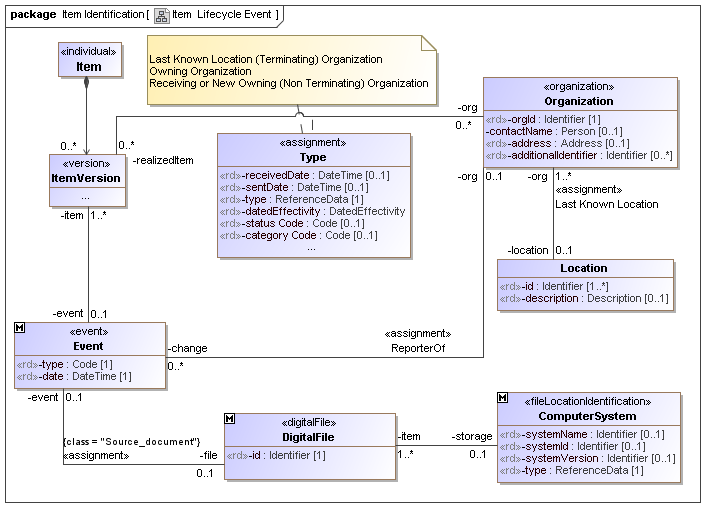
NOTE Details on the PLCS representation of the Item Lifecycle Event are defined in 239 Representation Item Lifecycle Event
Uniquely identified individual item.
The organization that recorded and provided the lifecycle event information.
Digital File with Event Information
Identification of the digital file containing the lifecycle event information.
Operator of the digital file containing the lifecycle event information.
System where the digital file containing the lifecycle event information originated from.
Version of the system that generated the digital file containing the lifecycle event information.
Classification of the type of system that generated the digital file containing the lifecycle event information.
An indicator of the type of lifecycle event.
EXAMPLE Abandoned, consumed, reintroduced, etc.
Date the event occurred.
The location of the item prior to the terminating event.
Organization that owns the item.
New Owning or Receiving Organization
The organization that receives/received delivery of the item or the new owner of the item as a result of a non-terminating event.
Additional information regarding the last known location or the recipient organization.
EXAMPLE If the item was lost at sea, the geographic location of the item prior to its loss would be recorded.
© OASIS 2010 — All rights reserved